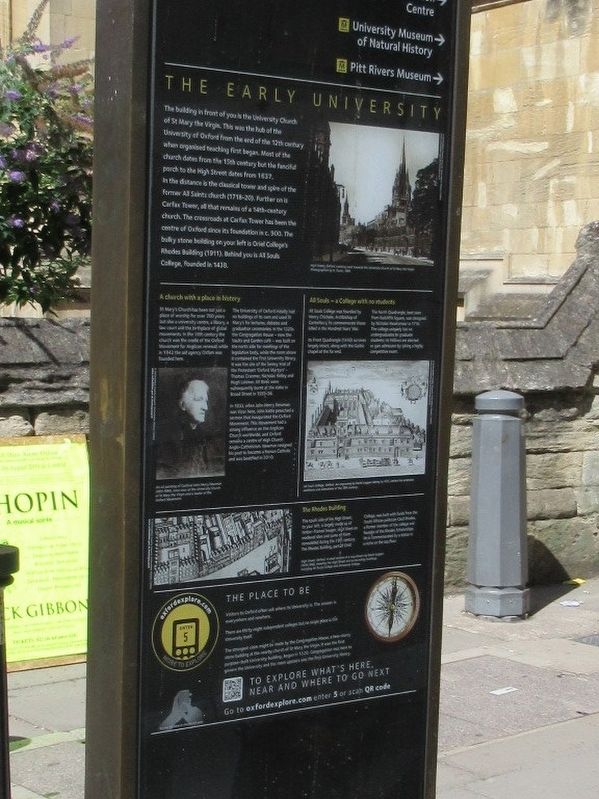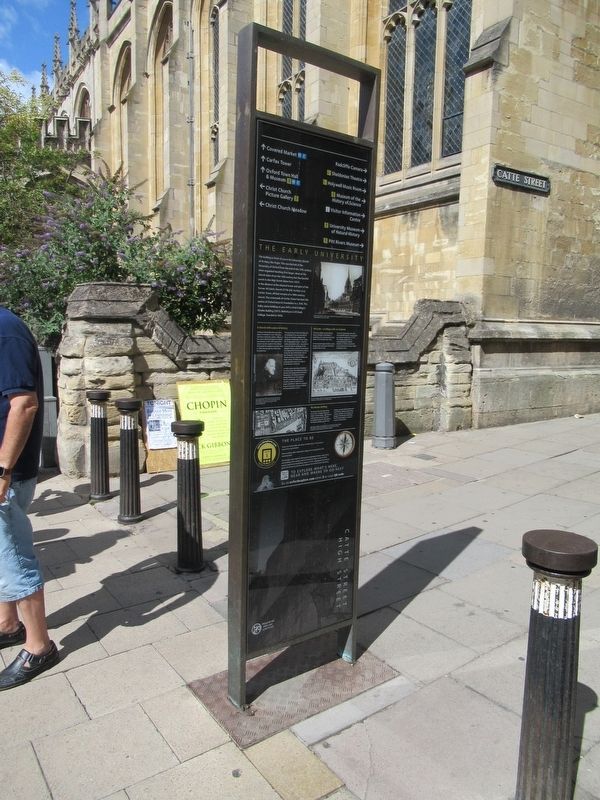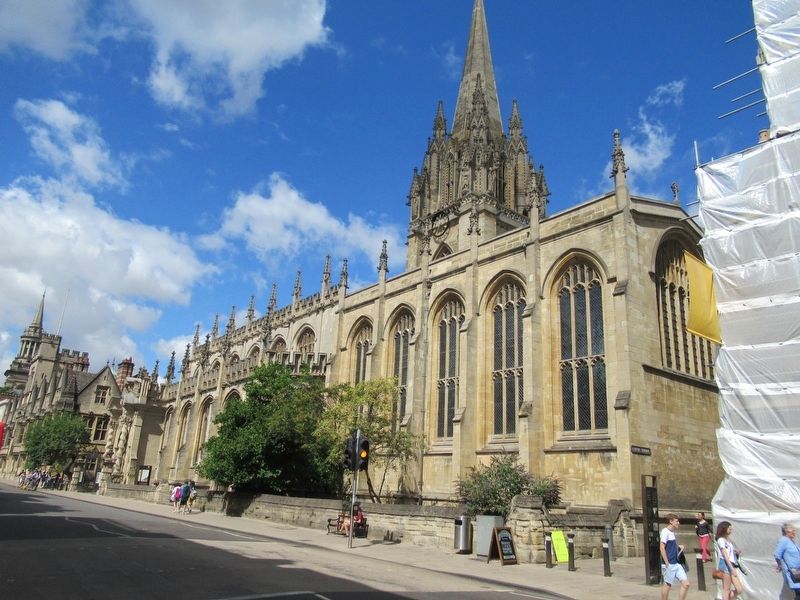Oxford in Oxfordshire, England, United Kingdom — Northwestern Europe (the British Isles)
The Early University
The building in front of you is the University Church of St Mary the Virgin. This was the hub of the University of Oxford from the end of the 12th century when organised teaching first began. Most of the church dates from the 15th century but the fanciful porch to the High Street dates from 1637. In the distance is the classical tower and spire of the former All Saints church (1718-20). Further on is Carfax Tower, all that remains of a 14th-century church. The crossroads at Carfax Tower has been the centre of Oxford since its foundation in c. 900. The bulky stone building on your left is Oriel College's Rhodes Building (1911). Behind you is All Souls College, founded in 1438.
A church with a place in history
St Mary's Church has been not just a place of worship for over 700 years but also a university centre, a library, a law court and the birthplace of global movements. In the 19th century the church was the cradle of the Oxford Movement for Anglican renewal, while in 1942 the aid agency Oxfam was founded here.
The University of Oxford initially had no buildings of its own and used St Mary's for lectures, debates and graduation ceremonies. In the 1320s the Congregation House - now the Vaults and Garden café - was built on the north side for meetings of the legislative body, while the room above it contained the first University library. It was the site of the heresy trial of the Protestant 'Oxford Martyrs' - Thomas Cranmer, Nicholas Ridley and Hugh Latimer. All three were subsequently burnt at the stake in Broad Street in 1555-56.
In 1833, when John Henry Newman was Vicar here, John Keble preached a sermon that inaugurated the Oxford Movement. This Movement had a strong influence on the Anglican Church worldwide, and Oxford remains a centre of High Church Anglo-Catholicism. Newman resigned his post to become a Roman Catholic and was beatified in 2010.
All Souls – a college with no students
All Souls College was founded by Henry Chichele, Archbishop of Canterbury, to commemorate those killed in the Hundred Years’ War.
Its Front Quadrangle (1443) survives largely intact, along with the Gothic chapel at the far end.
The North Quadrangle, best seen from Radcliffe Square, wes designed by Nicholas Hawksmoor in 1716. The college uniquely has no undergraduates or graduate students; its Fellows are elected or gain admission by taking a highly competitive exam.
The Rhodes Building
The south side of the High Street, to your left, is largely made up timber-framed houses, all of them on medieval sites and some of them remodeled during the 18th century. The Rhodes Building, part of Oriel College, was built with funds from South African politician Cecil Rhodes, a former member of the college and a founder of the Rhodes Scholarships. He is commemorated by a statue in a niche on the top floor.
The Place To Be
Visitors to Oxford often ask where its University is. The answer is everywhere and nowhere.
There are thirty-eight independent colleges but no single place is the University itself.
The strongest claim might be made by the Congregation House, a two storey stone building at the nearby church of St Mary the Virgin. It was the first purpose-built University building, begun in 1320. Congregation met here to govern the University and the room upstairs was the first University library.
Topics. This historical marker is listed in this topic list: Education.
Location. 51° 45.162′ N, 1° 15.195′ W. Marker is in Oxford, England, in Oxfordshire. Marker is at the intersection of High Street and Catte Street, on the left when traveling east on High Street. Touch for map. Marker is in this post office area: Oxford, England OX1 4AL, United Kingdom. Touch for directions.
Other nearby markers. At least 8 other markers are within walking distance of this marker. The High Street (about 120 meters away, measured in a direct line); Radcliffe Square (about 150 meters away); George Claridge Druce (about 150 meters away); Great Jewry (approx. 0.3 kilometers away); This Stone
(approx. 0.3 kilometers away); Cornmarket & Market St (approx. 0.3 kilometers away); The Crown (approx. 0.4 kilometers away); Reredos Memorial (approx. 0.4 kilometers away). Touch for a list and map of all markers in Oxford.
Also see . . . Explore Oxford. (Submitted on October 5, 2018, by Michael Herrick of Southbury, Connecticut.)
Credits. This page was last revised on January 27, 2022. It was originally submitted on October 5, 2018, by Michael Herrick of Southbury, Connecticut. This page has been viewed 152 times since then and 4 times this year. Photos: 1, 2, 3. submitted on October 5, 2018, by Michael Herrick of Southbury, Connecticut.


